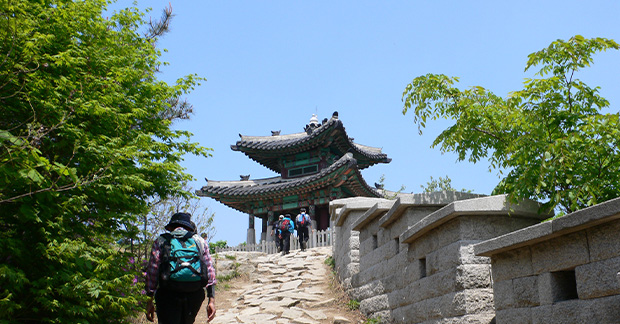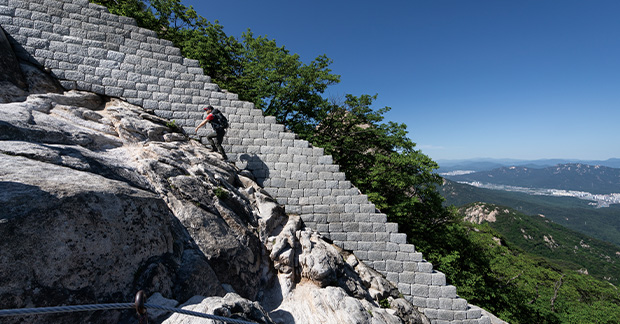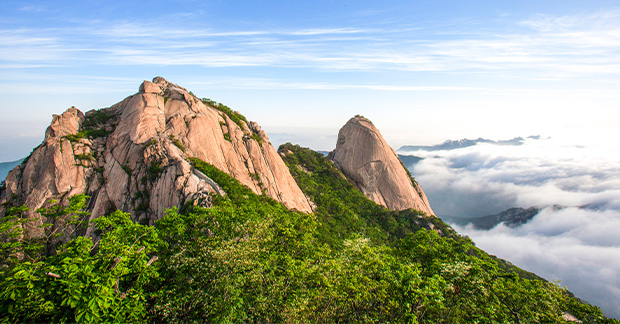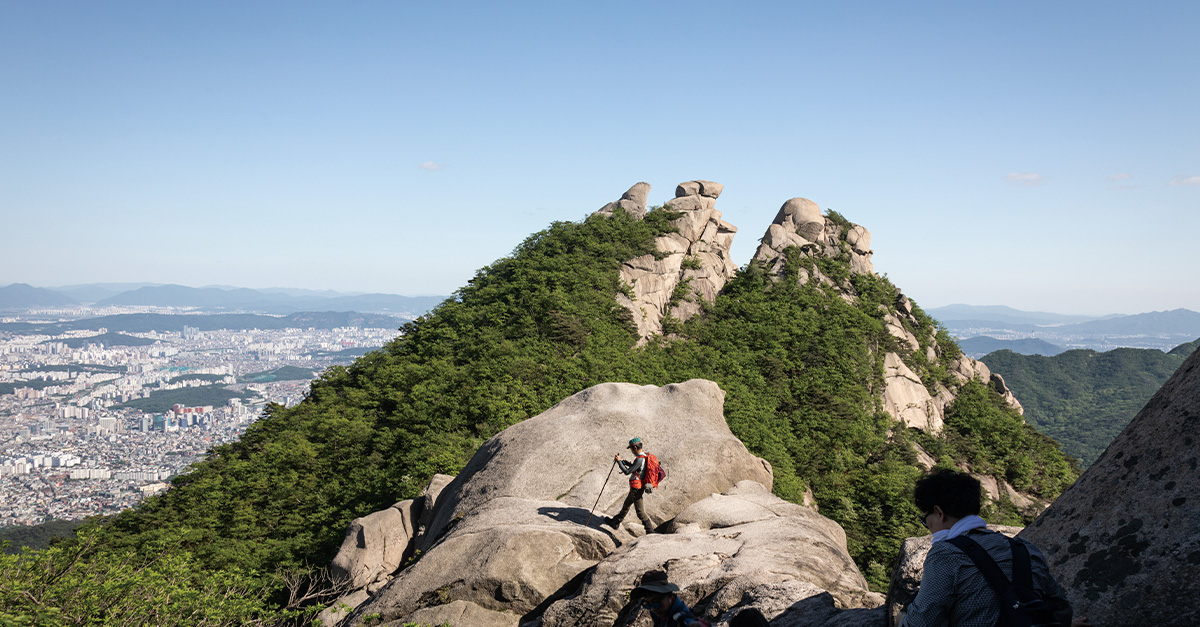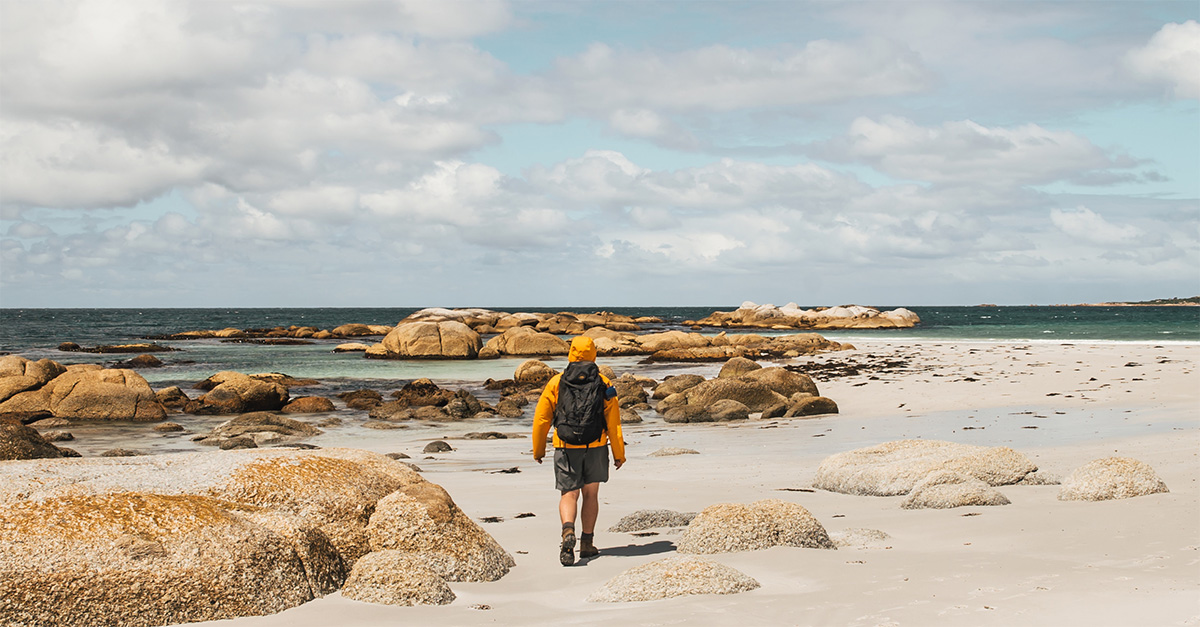You are viewing 1 of your 2 free articles
Skyscrapers and shrines in Seoul’s Bukhansan National Park
Skyscrapers aren’t the only thing elevating Seoul to new heights, discovers Alice Barnes-Brown
Click here to download and save as a PDF
In the autumn morning light, I can see every colour of her fur: white, ginger, gold and tabby. I approach, but this feral cat – which has made Seoul’s Bukhansan National Park her patch – will not be disturbed. She’s resting in front of a red-leaved Korean maple, on the edge of a precipice, blinking serenely into the sunlight.
I pause to take in the scene as a man sits down silently beside her; man and cat both admiring the same view. Like yin and yang. Taegeuk – South Korea’s version of yin and yang – is everywhere you look. About 70% of the country’s land is covered in mountains, and uber-modern mega-cities such as Seoul spring up in the valleys. Yet comparatively few visitors venture out into Korea’s natural landscapes.

A feral cat
Growing tourism in Korea
British travellers are increasingly interested in South Korea; InsideAsia says it’s the company’s fastest-growing destination, with about half of its enquiries focusing on the country.
Korean culture has well and truly exploded: K-pop (which burst on to the international scene in 2012 with Gangnam Style) regularly makes the music charts, TV shows such as Squid Game and Parasite are mainstream, and K-beauty and fashion are making their way on to British high streets.
Though Korea’s tourism industry was slow to recover from the pandemic – 11 million people visited in 2023 compared with 17.5 million in 2019 – it’s determined to see those numbers grow. In fact, 2024 is ‘Visit Korea Year’, so the government has prolonged its ETA-waiver programme for British travellers until the end of the year.
Seoul Hiking Tourism Center, which opened in 2022 near the entrance to Bukhansan National Park, caters to growing numbers of tourists keen to explore Korea’s hiking opportunities, offering information on trails, as well as lockers, showers and equipment rental.
Our guide Roger gets us booted up and gives our group of international travel agents a choice of two routes to the top of 837m-high Baegundae mountain: the quicker way, which is a four to five-hour round trip, or a slightly easier but longer way.

The mountain trail
Hiking up Baegundae Mountain
We choose the quicker route, but we’re immediately thrown into boulder-clambering, and find ourselves overtaken by Seoul’s spritely senior citizens. After about 30 minutes, we stop for our first rest – meeting many of the mountain’s feline inhabitants – and take a seat at a picnic area, which has plenty of locals sipping beer and eating lunch together.
Here, we get our first glimpse of our target: Baegundae Peak, a great granite sugarloaf (and Seoul’s tallest mountain) that seems indomitable against the brilliant blue sky. “Quite spectacular, eh?” Roger asks. I nod, but I wonder how we’ll make it to the top without any experience or equipment. A few icy-creek crossings later, we reach Insuam, a hermitage where a sole Buddhist monk maintains the shrine and performs regular prayers.
His Sanskrit mantras reverberate through the valley, and the prayer ribbons seem to sway in time. Willed on, we reach a second rest stop, equipped with toilets, a cafe and a small information centre. Thanks to these plentiful facilities, Korean mountains are often suitable for hiking at all times of the year – even when they’re covered in fresh snow.

The Bukhansanseong wall
A sign says we’re only 300m from the top, but it’s the toughest section yet. As the trees thin out to make way for the summit, we stumble upon a piece of Korean history. A 7.5-mile-long, early-18th-century wall called Bukhansanseong weaves its way across the ridges of Bukhansan National Park, designed to keep would-be invaders out.
Helpful information boards explain that the gate we’re looking at was once used to bring weapons, food and reinforcements into the Bukhansanseong fortress without being seen. We follow the course of the wall until it takes a dramatic vertical turn. At this point, the path gives way to raw rock, scalable only with the help of good hiking shoes, grippy gloves and via ferrata-like railings. I see people sliding down on their bottoms, while I struggle to haul my bodyweight up.
Granite mounds emerge from verdant misty valleys punctuated by tiny temples
But the views near the top made every bead of sweat worthwhile. On one side, there are Seoul’s suburbs, with white apartment blocks resembling Lego bricks lining the Han River almost as far as the eye can see.
However, they eventually recede into a sea of green trees, as the might of the mountains takes hold. I climb slightly higher to reach the summit. It’s standing-room only, with just enough space for a South Korean flag and 10 worn-out climbers.
On the other side of Baegundae, granite mounds emerge from verdant misty valleys punctuated by tiny temples, distinguished by their pagodas and colourful pillars. “It’s the epitome of an oriental landscape,” says Roger. We nod in silence. These seemingly diametric views of Seoul are two sides of the same coin – Taegeuk in action.

Baegundae Peak
Ask the expert

Roger Shepherd, founder, HikeKorea
“South Korea offers many opportunities for the more adventurous. I like to recommend a tailor-made, multi-day hiking tour with a private guide and vehicle. We climb a new peak each day, staying in local hotels and eating local cuisines. A sleepover in a remote Buddhist temple can also be arranged. Such tours include lessons by your guide on Korean culture and history, and lots of encounters with Koreans.”
Selling tips

Rebecca Barry, senior South Korea product executive, InsideAsia
? There’s so much beyond Seoul. Highlight the coast, off-radar rural villages and historic cities with incredible architecture.
? There are some things that clients can experience only in South Korea. These include a stay in a traditional hanok (house) in Jeonju city, which is accessible from Seoul by high-speed train.
? South Korea has similar seasons to Japan, including cherry blossom in early spring. Although it’s busy, there are fewer tourists. The country also shares impressive autumn colours and beautiful snowy landscapes in winter.
Book it
InsideAsia offers a seven-night Essential South Korea itinerary, which can be tailored to include a day’s hiking in Bukhansan National Park. Prices start at £2,580 including flights, B&B accommodation, all transportation, airport transfers and some private guides.
insideasiatours.com
PICTURES: Visit Seoul; Sebastian Schutyser; Alice Barnes-Brown
Read more
There’s a tour to suit every type of solo traveller
Eat your way around the world on these new food-themed escorted tours
South Korea: 48 hours in Seoul for foodies



